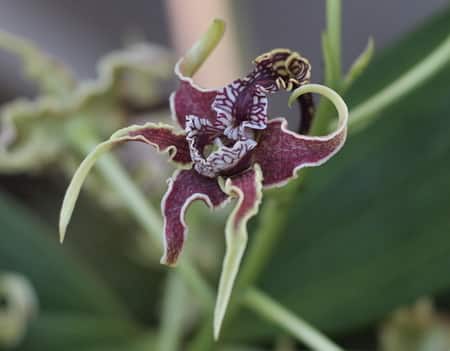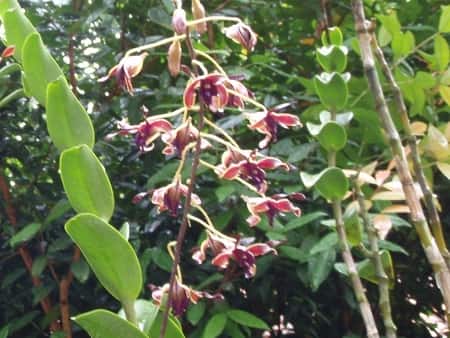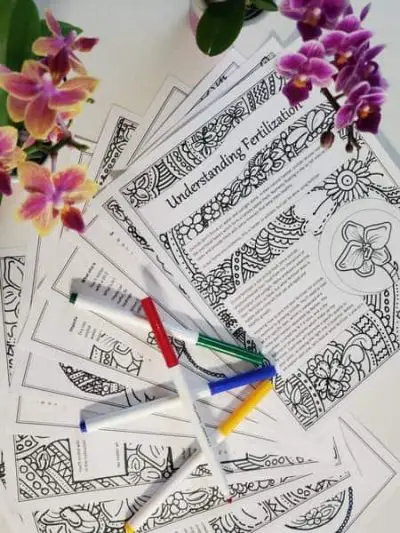Dendrobiums are the 2nd largest genus in the orchid family with over 1,400 cataloged species. These orchids grow in a vast array of conditions: monsoons, tropical rain-forest, to cool and drier climates. They have so many differences between the species that it’s almost impossible to write a general care and culture guide for them.
Besides the fact that they are light-loving orchids, there is one thing that you can guarantee for having good growth on your Dendrobium orchid—ensuring good roots.
What ensures healthy Dendrobium roots?
To have healthy Dendrobium roots, 5 conditions must be met: (1) the Dendrobium orchid needs to be root-bound, (2) potted in a high-drainage medium, (3) be free of pests and insects, (4) receive sufficient water, and (5) have all dead roots removed.
Let’s look at those items one by one.
1) The Dendrobium roots need to be rootbound
Dendrobiums have shorter roots for the elongated size of their canes. The top growth is quite heavy and long, and we tend to look at the tiny pot and wonder how they ever grow. Reacting in tender loving care towards what we think is a suffering orchid, we repot it into a pot that is vastly larger than it needs.
Dendrobium’s roots need to be root-bound and under-potted for several reasons. If they don’t adhere to the sides of the pot, the long canes will not have the stability they need. This can cause the pot to topple over. If you want, you can add rocks to the bottom of the pot for additional weight. Terracotta pots are excellent choices for dendrobium’s roots because they provide both the stability, cooler temperatures, and higher humidity that some Dendrobium species require.
Always stake your Dendrobium orchid, especially after a repot. The orchid’s roots aren’t deep or strong enough to support the weight or height of the canes. Staking guarantees your orchid won’t be shaking around in the pot, destroying or damaging new roots.

Rhizome clips are another way to keep the Dendrobium orchid secure in the pot until it becomes root bound.
Since the new roots are not that deep, a rhizome clip—a metal wire that fastens onto the side of the pot and crosses the diameter of the top media—holds the rhizome down into the media and prevents it from lifting or moving when new growth starts.
To read more about this topic, this article about rootbound orchids goes into more depth than I can explain here.
2) Dendrobium Roots Need a High-Drainage Medium
Dendrobium roots (for the most part) like to be heavily watered. Out of the 1,400 species of orchids that encompass the Dendrobium genus, most are water-thirsty orchids. If their medium doesn’t drain properly, they will not breathe inside the pot. Contrary to popular belief, the over-watering doesn’t cause root rot, but the lack of circulating air inside the media does.
If you water a Dendrobium orchid inside a pot that doesn’t let the water flow freely, exiting the vase, then water pools inside. The water prevents the pores on the roots to release volatile elements that they don’t need. Since water prevents gas exchange, the waste elements accumulate, forming a chemical compound that destroys the root cells and the velamen cells.
Toxic chemicals are formed because the water prevents the gas exchange.
In nature, these roots wouldn’t be in a pot (unless your Dendrobium is terrestrial). They would be aerial, attached to the sides of trees. They would receive the rain from above and all the nutrients necessary for life from the abundance of forest life around them.
In a pot, they don’t have that privilege. If they didn’t like as much water as they do—Dendrobiums are similar to Cattleyas in there watering preferences in that they like to dry out before being soaked again—then having a media that absorbed water would be preferred. But since they constantly like to be watered, and constantly like to dry out afterward, they need to have the appropriate medium.
What’s the best potting medium for Dendrobium orchids? I can’t answer that specifically, since I don’t know where you live, your watering routine, or how you grow your orchids. What I can do, is give you a few tips.
Stay away from coconut husks and fibers. In the past, they have been used for Dendrobiums, but recently (as in the last 10-15 years) the salt content in them is way too high for the orchid roots to tolerate. The high salt burns them over time. They also hold more moisture than the Dendrobium would like, and the roots become damaged with the excessive water.
Most orchid growers have had success with leca beads (didn’t work for me) and orchid bark (bark worked). Again, find a medium that you feel comfortable with and learn from it.
3) Dendrobium Roots Need to be Pest and Insect-Free
Since Dendrobiums require higher water levels, they can also attract insects that prefer higher humidity. Inside the potting medium is a perfect place for little critters to hide out and create an infestation. The most common pests that infest Dendrobium orchids include scale, aphids, thrips, false spider mites, and snails.
To rid your Dendrobium orchid of these pests, you can read this article about pesticides and insecticides, where you’ll get an overview of what to use in each circumstance.
In any case, the life of a Dendrobium orchid is in its roots. If it doesn’t have healthy roots, it won’t show any signs of life. You can add more water, increase sunlight, add fertilizer supplements, but if the root system isn’t good, your Dendrobium will not gain from your effort. Contrary to the bugs that inhabit the sphagnum moss (which is this article) most Dendrobium pests and insects do not live in the potting medium.
They rather make their way around the canes, where they suck the sap out of the leaf and pseudobulb. They bore into the roots and shoots, feeding on the orchid juices and sap.

4) Dendrobium Roots must Receive Plenty of Water
Most of the 1,400 species of Dendrobium orchids need more water during active growth. Some are dormant, where you’ll need to suspend or diminish the water quantity and quality for a few months.
Before you water hall your orchid, research the specific species of orchid you have and where it lives naturally. This article shows the 5 main categories of Dendrobiums and the main characteristics of each. When doing your own research, check out items like humidity, airflow, watering, altitude, sun, temperatures, and what the general climate is like during the course of the year. This is your best teacher.
Dendrobiums (for the most part) will like to receive more water than a Phalaenopsis does, wanting to partially dry out before another watering. Don’t ever let the media get too dry, though. Keep the bottom 1/3 moist at all times—moist, not soggy.
The first sign of not watering enough is that the Dendrobium canes will shrivel and look extremely wrinkled. What is happening is that the roots are not absorbing the water you are providing, or you are not providing enough water. Both will cause dehydration. If the Dendrobium canes aren’t wrinkled but have small wedges or creases, you’re doing fine with your watering schedule.
If you are watering too much or too often (over-watering is in 2 aspects: quantity and frequency) the first sign that is visible is root rot. If this rot continues, it will travel upward to the cane sand cause pseudobulb rot.
5) Remove all Dead Dendrobium Roots
When it comes time to repot, after the first new Dendrobium roots shoot out but haven’t reached the potting medium yet, it’s time to repot. There is nothing worse for your orchid than to have dead roots inside a space that already is disputed.
All dead roots have to go. If they stay inside the pot, they decompose due to the bacteria that is already present. Yet this chemical release signals to other bacteria that this potting media is a vast source of energy and nutrients, and they spread like wildfire. Fungus, which feeds on bacteria, also infects the scenario. Months later, your orchid has hardly any live roots left.
Roots aren’t meant to live forever. That is why each new season, your Dendrobium orchid sends out new roots and leaves. These die off naturally except in nature, they die and fall to the ground. They don’t stay in close contact with the orchid, as the root-bound and under-potted Dendrobium roots are.
Be extra careful to remove all dead, mushy, non-resilient roots. Press on the roots to verify their firmness. Color is not always the best indication since roots that do not receive light will be naturally yellow. (You can read more about yellow roots in this article.)
Squeeze and note their firmness. If they squish between your fingers, cut them off. Any Dendrobium roots that are brittle even after watering also need to be cut off.
Don’t Stop Learning!
If you want to be included in more information and get a 14-page fertilization guide, please sign up for my newsletter. I don’t spam, but send emails out bi-monthly with some curious topics of interest. If you want more information, click here to go to a specific page on this website where I explain it more in detail.

Also, if you are looking for an orchid journal to keep your notes specifically about orchid care, check out my 2 solutions for that on this page. If note-keeping isn’t your thing, then there is a free excel spreadsheet that you can download. Click here for more information on how to do that.
If you subscribe to my newsletter, I will send you a 14-page guide on the main tips of orchid fertilizer. It is downloadable and you can print it out on your computer. I designed the guide to double up as a coloring book, just to make it fun.
Further Reading Suggestions:
Don’t just take my word for what is written here. Continue researching other articles about Dendrobium Roots, because everyone has a different point of view and unique techniques that work for them. Here are a few other articles from other websites if you’d like to continue your research on Dendrobiums Roots:
Bacterial Diseases of Dendrobium  written by Janice Uchida, Associate Professor, Department of Plant Pathology, CTAHR, University of Hawaii explains the bacterial problems that are common in Dendrobium orchids. This article doesn’t only focus on the roots, but is an excellent source of information for caring for your Dendrobium.
written by Janice Uchida, Associate Professor, Department of Plant Pathology, CTAHR, University of Hawaii explains the bacterial problems that are common in Dendrobium orchids. This article doesn’t only focus on the roots, but is an excellent source of information for caring for your Dendrobium.
If you’re not looking your bacterial problems, but more of an insect or pest problem with your Dendrobium, check out this article Pests associated with orchid Dendrobium nobile under Mid-Altitude of Sikkim written by Vislesh Nagare and published in Environment and Ecology talks about an experiment done with a Dendrobium and the types of pests it attracts. When you open the page you’ll see the abstract, but scroll down to read the full article.
written by Vislesh Nagare and published in Environment and Ecology talks about an experiment done with a Dendrobium and the types of pests it attracts. When you open the page you’ll see the abstract, but scroll down to read the full article.
Happy Cultivating!


I have dendrobium with no roots. But stem and leaves are green. What to do next for root care?